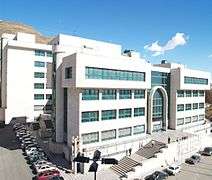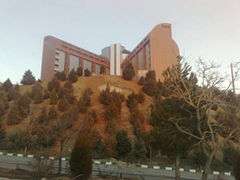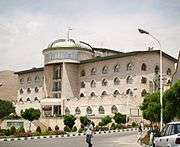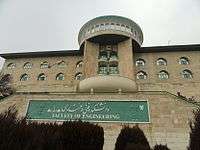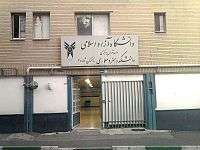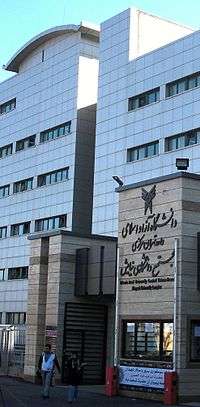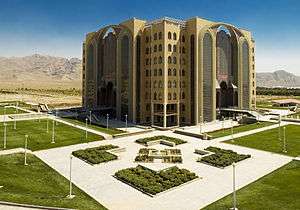Islamic Azad University
| |
|
Seal of the Islamic Azad University | |
| Motto | آرمان ایرانی برای جهانی شدن (Persian) |
|---|---|
Motto in English | Iranian Aspirations for Globalization |
| Type | Private University System[1] |
| Established | 1982 |
| Founder | Akbar Hashemi Rafsanjani |
| Endowment | 140,955,000 USD[2] |
| President | Hamid Mirzadeh, Ph.D. |
| Vice-president | Farhad Hosseinzadeh Lotfi, Ph.D. |
Academic staff | 70,000 (2015)[2] |
| Students | 1,702,231 (2015)[2] |
| Undergraduates | 1,544,434[2] |
| Postgraduates | 157,797[2] |
| Campus | 2 independent and 31 state university branches with 400 campuses and research centers in Iran, and 4 branches overseas under direct administration |
| Media | Farhikhteghan Newspaper, Afarinesh Newspaper, Azad News Agency (ANA), Isca News Agancy |
| Colours | Dark and light Blue[3] |
| Athletics |
Azad University of Tehran Basketball Club Azad University of Tehran Cycling Club |
| Sports | Azad University Giant Team |
| Nickname | IAU |
| Affiliations |
Islamic Azad University system SCRC FUIW IAU TWAS |
| Website |
www |
|
| |
The Islamic Azad University (IAU) (Persian: دانشگاه آزاد اسلامی, Dāneshgāh-e Āzād-e Eslāmi), commonly referred to as Azad University is a private university system in Iran. It is one of the largest comprehensive system of universities, colleges, and community colleges in the world.
History
Headquartered in Tehran, Iran, the Islamic Azad University is the world's third largest university which was approved and ratified by Supreme Council of the Cultural Revolution in 1982 and was founded in 1982 and established by Akbar Hashemi Rafsanjani,[4] currently has an enrollment of 1.7 million students.[5][6] IAU is one of the greatest success stories of higher education in Iran and the region, if not in the World. Since its inception in 1982, it has grew profoundly both physically and academically to become one of the largest higher education institutions globally. Over the years, IAU has promoted 'higher education for all' as its key objective. This has been a challenging task but the university managed to overcome many of the challenges by creating a community of hardworking students and staff in every corner of the Iran. IAU has 2 independent and 31 state university branches across the country, and also 4 branches in other countries. It has university branches in U.A.E., United Kingdom, Lebanon and Afghanistan.[7] Over the years, the university has accumulated assets estimated to be worth between $20–25 billion.[2][6] The Islamic Azad University's activities quickly expanded throughout the country, so that today thousands of students are enrolling every year. Not relying on government funding, it receives charitable donations and charges tuition fees.[6]
The certificates issued by this university are recognized by the Ministry of Science, Research and Technology and Ministry of Health and Medical Education for medical education.[7] Azad University admits students through the National Wide Entrance Examination held by the National (Iranian) Organization of Educational Testing.
Endowment controversy
Iran's Supreme Leader has declared the financial endowment of Islamic Azad University to be "religiously illegitimate and unlawful", prompting a change within the administration of the institution.[8]
The university branches and campuses
The Islamic Azad University has 2 independent[9] and 31 state university branches with 400 campuses and research centers in Iran, and 4 branches overseas, scattered over an area exceeding 20 million square meters, together with a range of hospitals, laboratories, workshops, sports facilities, recreational areas and ITC facilities, IAU now welcomes many applicants locally and internationally. All this together with 621 Sama high schools affiliated to the university, along with 124 technical and vocational colleges.[2] These campuses are under the direct control of the Bord of Trustees and the President. Only eleven best and famous branches are listed below. Some branches are well-known, most distinguished, most highly ranked and most prestigious specially Central Tehran and Science and Research.
| Branch | Type | Founded | Enrollment |
|---|---|---|---|
| Science and Research | Independent Comprehensive | 1984 | ~ 50,000 |
| Najafabad | Independent Comprehensive | 1985 | ~ 25,000 [10] |
| Central Tehran | Comprehensive | 1982 | ~ 60,000 |
| South Tehran | Comprehensive | 1985 | ~ 35,000 |
| North Tehran | Comprehensive | 1985 | ~ 30,000 |
| Tehran Medical | Comprehensive | 1985 | ~ 15,000 |
| Karaj | Comprehensive | 1984 | ~ 35,000 |
| Tabriz | Comprehensive | 1982 | ~ 21,000 |
| Qazvin | Comprehensive | 1992 | ~ 28,000 |
| Mashhad | Comprehensive | 1982 | ~ 30,000 |
| Isfahan | Comprehensive | 1983 | ~ 15,000 |
Branches in the City of Tehran
| Branch | Type | Founded |
|---|---|---|
| Science and Research | Comprehensive | 1984 |
| Central Tehran | Comprehensive | 1982 |
| South Tehran | Comprehensive | 1985 |
| North Tehran | Comprehensive | 1985 |
| West Tehran | Great | 1994 |
| East Tehran | Very Great | 2001 |
| Tehran Medical | Comprehensive | 1985 |
| Tehran Dental | Very Great | 1985 |
| Pharmaceutical Sciences | Very Great | 1985 |
| Electronic | Moderate | 2007 |
Two-year institutions
Sama Technical and Vocational College
Educational institutions
Sama Schools (Primary schools, Secondary schools, Elementary schools, High schools and University-preparatory schools)
Overseas branches
The Azad University in Oxford (AUO) is one of the IAU overseas branches located at the outskirts of Oxford city in the UK. It has been established in 2004 to support the IAU international collaboration activities. Through its links with the UK universities and research centres, the AUO provides a number of services to the students and staff of IAU as well as other students and organisations around the world.[11]
In 1995, a branch was opened in Dubai.[12]
International Offices
The Islamic Azad University has international offices in Russia, Italy, Germany, UK, UAE, Lebanon and Afghanistan.[13]
State universities
IAU has 31 state universities (provincial universities) in each province of Iran that are listed below:
- Islamic Azad University, Alborz Province
- Islamic Azad University, Ardabil Province
- Islamic Azad University, East Azerbaijan Province
- Islamic Azad University, West Azerbaijan Province
- Islamic Azad University, Bushehr Province
- Islamic Azad University, Chahar Mahaal and Bakhtiari Province
- Islamic Azad University, Fars Province
- Islamic Azad University, Gilan Province
- Islamic Azad University, Golestan Province
- Islamic Azad University, Hamadan Province
- Islamic Azad University, Hormozgan Province
- Islamic Azad University, Ilam Province
- Islamic Azad University, Isfahan Province
- Islamic Azad University, Kerman Province
- Islamic Azad University, Kermanshah Province
- Islamic Azad University, North Khorasan Province
- Islamic Azad University, Razavi Khorasan Province
- Islamic Azad University, South Khorasan Province
- Islamic Azad University, Khuzestan Province
- Islamic Azad University, Kohgiluyeh and Boyer-Ahmad Province
- Islamic Azad University, Kurdistan Province
- Islamic Azad University, Lorestan Province
- Islamic Azad University, Markazi Province
- Islamic Azad University, Mazandaran Province
- Islamic Azad University, Qazvin Province
- Islamic Azad University, Qom Province
- Islamic Azad University, Semnan Province
- Islamic Azad University, Sistan and Baluchestan Province
- Islamic Azad University, Tehran Province
- Islamic Azad University, Yazd Province
- Islamic Azad University, Zanjan Province
Distribution of students
In academic year of 2014-2015
| Field of Study | Percent |
|---|---|
| Engineering | 42% |
| Humanities | 37.11% |
| Art | 6.84% |
| Science | 5.68% |
| Agriculture and Veterinary | 4.41% |
| Medical Science | 3.96% |
| Total[2] | 100% |
Distribution of graduates
In academic year of 2014-2015
| Field of study | Percent |
|---|---|
| Engineering | 43.54% |
| Humanities | 40.71% |
| Art | 4.99% |
| Science | 5.47% |
| Agriculture and Veterinary | 4.64% |
| Medical Science | 0.65% |
| Total[2] | 100% |
| Level of study (Degree) | Percent |
|---|---|
| Associate | 25.97% |
| Bachelor's | 64.76% |
| Master's | 9.08% |
| Ph.D. | 0.13% |
| M.D. | 0.06% |
| Total[2] | 100% |
Medical centers
IAU is currently offering assistance in many hospitals and has also obtained the necessary approvals to establish new hospitals with nearly a capacity of 1000 beds. In following you will find more details:[2]
- 89 branches in medical sciences
- 1578 faculty members
- 72226 students
- 51 majors in different levels
- Over 1500 active beds in 11 hospitals in Iran. Each medical center serves as the primary teaching site for that campus's medical school. Some hospitals are listed below:
- Bou-Ali (Avicenna) Hospital in Tehran, Iran
- Amiralmomenin Hospital in Tehran, Iran
- Javaheri Hospital in Tehran, Iran
- 22 Baham Hospital in Mashhad, Iran
- Aria Hospital in Mashhad, Iran
- IAUN Hospital in Najafabad, Isfahan, Iran (Under construction)
- Yazd Hospital
- Khatamalanbia Hospital
- Rhazes Hospital
- Katalem Hospital
Rankings
ISC Rankings
In early 2011, Islamic World Science Citation Database declared the very first official ranking of Higher education and research institutes of Iran,[14] including a ranking of Islamic Azad University branches:[15][16]
| Rank | Branch | Score |
|---|---|---|
| 1 | Tabriz | 4.27 |
| 2 | Mashhad | 3.51 |
| 3 | Central Tehran | 3.06 |
| 4 | Karaj | 2.61 |
| 5 | North Tehran | 2.48 |
| 6 | Najafabad | 1.37 |
| 7 | Isfahan (Khorasgan) | 1.35 |
| 8 | Quchan | 1.26 |
| 9 | Shabestar | 1.19 |
| 10 | Ardabil | 0.95 |
| Rank | Branch | Score |
|---|---|---|
| 1 | Science and Research | 100 |
| 2 | Mashhad | 23.75 |
| 3 | Karaj | 18.53 |
| 4 | South Tehran | 18.21 |
| 5 | Isfahan (Khorasgan) | 13.5 |
| 6 | North Tehran | NA |
| 7 | Najafabad | NA |
| 8 | Qazvin | NA |
| 9 | Central Tehran | NA |
| 10 | Yazd | NA |
SCImago rankings
2013: International rank: 87, National rank: 1, Regional Rank: 1[17]
2012: International rank: 231, National rank: 1, Regional Rank: 2[18]
Leiden Ranking – CWTS Leiden Ranking
2014: World rank: 252, Country rank: 11, Regional Rank: 194[19]
URAP – University Ranking by Academic Performance
2013: World rank: 161, Country rank: 1, Regional Rank: 25[20]
2012: World rank: 226, Country rank: 2, Regional Rank: 34[21]
Gallery
See also
- Colleges and universities
- Higher Education in Iran
- List of universities in Iran - including list of IAU branches
- Islamic Azad University, Science and Research Branch
- Islamic Azad University, Central Tehran Branch
- Islamic Azad University, South Tehran Branch
- Islamic Azad University, North Tehran Branch
- Islamic Azad University, Najafabad Branch
References
- ↑ Ahmad Ashraf, "EDUCATION vii. GENERAL SURVEY OF MODERN EDUCATION," Encyclopaedia Iranica, Online Edition, December 15, 1997, available at http://www.iranicaonline.org/articles/education-vii-general-survey-of-modern-education.
- 1 2 3 4 5 6 7 8 9 10 11 "IAU General Catalog 2015-2016" (PDF).
- ↑ "Islamic Azad University Logotype usage guidelines" (PDF). Islamic Azad University. Retrieved January 26, 2012.
- ↑ "Back to the Future in Iran's Election". The National Interest. Retrieved 16 July 2015.
- ↑ Encyclopaedia Britannica World Almanac, ed. 2004, page 666
- 1 2 3 http://www.turquoisepartners.com/iraninvestment/IIM-Jul10.pdf
- 1 2 Gholamreza Rahimi, Ghader Vazifeh Damirch, "Islamic Azad University Roles in Scientific Development of Iran", Interdisciplinary Journal of Research in Business, Vol. 1, Issue. 9, (pp. 84–91), September–October 2011, available at http://www.idjrb.com/articlepdf/idjrb9n1p9.pdf
- ↑ "The battle over Islamic Azad University". Foreign Policy. Retrieved 16 July 2015.
- ↑ "دانشگاه آزاد اسلامی نجفآباد، واحد جامع مستقل شد/ واحد جامع مستقل تابع استان نیست".
- ↑ http://iaun.ac.ir/index.php/progressive model school-count
- ↑
- ↑ http://iau.ae/iau2/at-a-glance/
- ↑ http://www.mehrnews.com/news/3835535/راه-اندازی-۱۶-دفتر-بین-المللی-دانشگاه-آزاد-در-خارج-از-کشور
- ↑ "نخستین رتبهبندی رسمی دانشگاهها و مراکز تحقیقاتی کشور اعلام شد". Retrieved 16 July 2015.
- ↑ وب سایت رتبه بندی دانشگاه های جهان اسلام
- ↑
- ↑ http://www.scimagoir.com/pdf/SIR%20Global%202013%20O.pdf
- ↑ http://www.scimagoir.com/pdf/SIR%20Global%202012%20O.pdf
- ↑
- //www.leidenranking.com/ranking/2014
- ↑ "URAP - University Ranking by Academic Performance". Retrieved 16 July 2015.
- ↑ "URAP - University Ranking by Academic Performance". Retrieved 16 July 2015.
External links
- Official Website (Persian)
- Alumni of Islamic Azad University (Persian)
Coordinates: 35°43′58″N 51°23′20″E / 35.7328°N 51.3889°E
.png)

